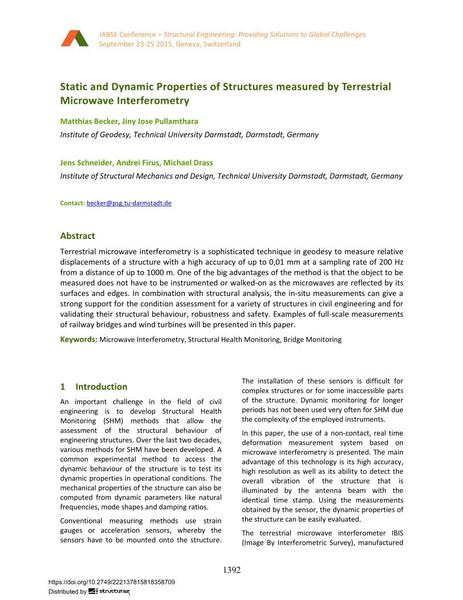Static and Dynamic Properties of Structures measured by Terrestrial Microwave Interferometry

|
|
|||||||||||
Détails bibliographiques
| Auteur(s): |
Matthias Becker
(Institute of Geodesy, Technical University Darmstadt, Darmstadt, Germany)
Jiny Jose Pullamthara (Institute of Geodesy, Technical University Darmstadt, Darmstadt, Germany) Jens Schneider (Institute of Structural Mechanics and Design, Technical University Darmstadt, Darmstadt, Germany) Andrei Firus (Institute of Structural Mechanics and Design, Technical University Darmstadt, Darmstadt, Germany) Michael Drass (Institute of Structural Mechanics and Design, Technical University Darmstadt, Darmstadt, Germany) |
||||
|---|---|---|---|---|---|
| Médium: | papier de conférence | ||||
| Langue(s): | anglais | ||||
| Conférence: | IABSE Conference: Structural Engineering: Providing Solutions to Global Challenges, Geneva, Switzerland, September 2015 | ||||
| Publié dans: | IABSE Conference Geneva 2015 | ||||
|
|||||
| Page(s): | 1392-1399 | ||||
| Nombre total de pages (du PDF): | 8 | ||||
| Année: | 2015 | ||||
| DOI: | 10.2749/222137815818358709 | ||||
| Abstrait: |
Terrestrial microwave interferometry is a sophisticated technique in geodesy to measure relative displacements of a structure with a high accuracy of up to 0,01 mm at a sampling rate of 200 Hz from a distance of up to 1000 m. One of the big advantages of the method is that the object to be measured does not have to be instrumented or walked-on as the microwaves are reflected by its surfaces and edges. In combination with structural analysis, the in-situ measurements can give a strong support for the condition assessment for a variety of structures in civil engineering and for validating their structural behaviour, robustness and safety. Examples of full-scale measurements of railway bridges and wind turbines will be presented in this paper. |
||||
